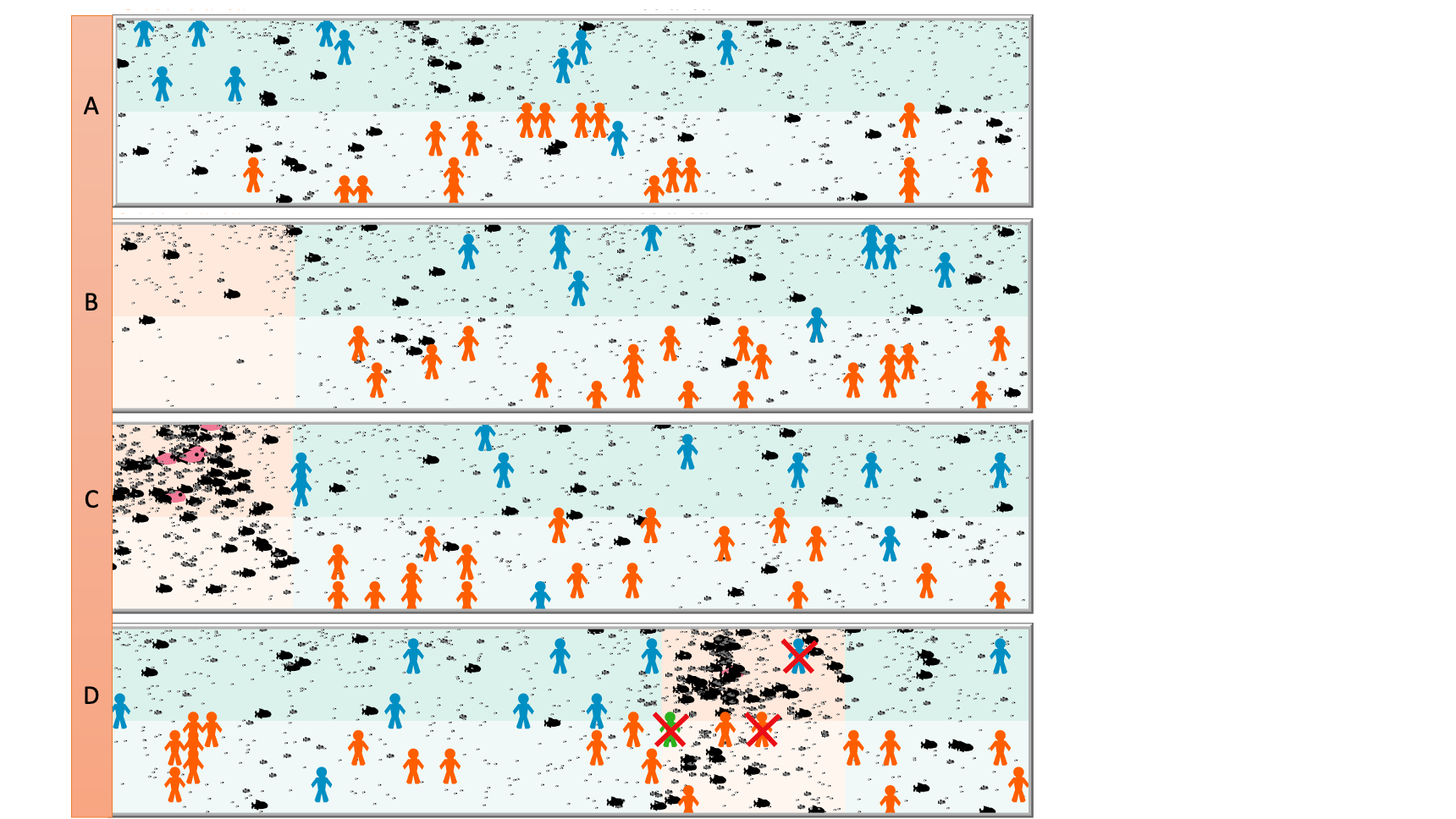Models can help us better understand the dynamics of/in human-ocean systems.
For TEMPO, this means dissecting closure characteristics to visualize their ecological and social outcomes. Our team asks specific questions we’re unlikely to answer with empirical data. The two model types let us develop social-ecological theory and unpack different closure design characteristics in relation to different fishery conditions. For example,
- Spatial: What trade-offs do we see with different closure sizes and different durations of a proposed closure?
- Does a large, 20-year closure create too much cost for fishers?
- Can any species benefit from a short, year-long closure?
- Human Compliance: How might parrotfish recover if some fishers poach within the closure?
- If the closure is closer to shore, how will human-fish interactions change?
Conceptual drawing in Agent-based Modeling

Agent-Based Model
Dr. Lindkvist leads our agent-based model (ABM; Figure ABM). This model is being developed and used to study the spatial and temporal dynamics and impacts of temporary closures on fish and fishers.
For example, we can test the size, location, and duration of closure in relation to species sustainability and equity issues, as well as interactions between compliance (e.g., poaching) and closure design factors.
In the TEMPO ABM, an "agent" is either a fisher or a fish. Each agent has different characteristics and can make decisions. For example, a fisher agent may decide to poach in the closure area depending on factors such as confidence in the closure intervention. A fish agent has a growth function and can respond to perturbations from fishing. We can also visualize how fish aggregates or whether poaching occurs (Figure ABM).

Figure ABM. Current version of the TEMPO ABM, which will be further developed throughout our project. Panel A; Fishers agents can fish in shallow and deep areas (blue), and agents that can only fish in shallow areas (orange). Panel B; A closure area is established. Panel C; After some time in the simulation, fish have grown and aggregated in the closure area. Panel D; After an even longer period of time, the closed area is moved to a new location and fish continue to accumulate, but now fishers also poach and sometimes get caught (represented by the red cross)
Bioeconomic Modeling
Dr. Aveces-Bueno’s Bioeconomic approach focuses on how closure management decisions lead to different costs and benefits for the fishing community — and who receives those costs and benefits. To understand these outcomes, she models decisions made during a closure’s design phase:
- What size should a closure be?
- How long should you close it for?
- Where should a closure be, relative to shore?
- How will each of these decisions impact different targeted fish species?
Modeling Agenda
Our plan is to combine theoretical insights from different closure design types and then contextualize the model with empirical data observed in case studies in Mexico and French Polynesia to address the research questions:
What are the social and ecological closure design features associated with systems where temporary closures are successful?
How do species characteristics (slow and fast growth, mobility levels) influence success?
How does fisher heterogeneity (e.g., gear types, access to when and where to fish, fishing abilities and desires) affect the distribution of benefits among different groups of fishers?
A successful closure can mean many different things depending on your role in the fishery. In the model, we can formalize and combine these to study the occurrence of win-win situations, e.g. how fishers trust the intervention, how they benefit or are affected equally, while the fish population is harvested sustainably.
Closure design features can include the length and size of the closure, life histories and growth rates of target species, and criteria for opening closures.
We can use the model to theorize about the effects of closures in a fishery where fishers have high or low confidence in the closure model, or how closures affect fast- and slow-growing target species in relation to their design. Through the visually realistic design of the ABM, we also hope to use the model in stakeholder workshops and/or other forms of communication regarding various types of closure designs.